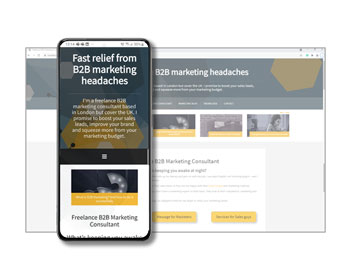Have you got too many sales leads from your B2B website? Probably not. I’ll guide you through 11 steps to create a production line of prospects.
There are some key elements to designing a lead generating B2B website; improving SEO to get low-cost visitors, encouraging action from those that are ready-to-buy and adding sticky content for the ‘window shoppers’. Let’s get started.
Improving Search Engine Ranking
You won’t generate sufficient leads if you are not maximising your B2B website visitors. My experience is that organic search visitors are the best. Sure, you can pay to drive traffic through digital ads, but it generally has a high bounce rate (and therefore high wastage).
1. Avoid the most competitive keywords
If you have limited resources, i.e. not many people in your marketing department, I would recommend initially avoiding the most competitive keywords – that’s not necessarily the same as avoiding the most popular.
Use tools like Wordtracker and Google Trends to discover the words and phrases your target audience is using – often it’s not the ones you imagine.
Wordtracker shows the volume of searches for words and phrases as well as the search competition (i.e. how difficult it is to get a high ranking).
You can often find a word/phrase that has a high volume, but low competition. That’s ideal.
2. Focus on your mobile version

Since March 2021 Google (which may account for 80% of your organic search traffic) has stopped indexing the desktop version of your site. It now only looks at the mobile phone version to decide where you rank in the search results.
As a result, build your B2B website in the tight framework of a mobile device, then expand onto the larger canvas of a desktop. But make sure all the essential ‘Google magnets’ are on your mobile version.
3. Add fresh content regularly
All search engines love fresh content. Think about it from their perspective. They didn’t build your website, but they are recommending it. They don’t want to recommend a site that is stale, it makes the search engine look bad.
4. Make your code search engine friendly
There are plenty of free tools that will help you improve your HTML, Java, CSS and other files. Here’s a list, all are free but many have paid versions with extra functionality.
Ahrefs – Optimise your website’s code, analyse your competitors, learn what your customers are searching for, and track your ranking progress.
SEMrush – Grows organic traffic with analysis of keywords, tracking backlinks and running technical SEO audits.
Google Page Speed – Analyses the desktop and mobile versions of your site, then it recommends ways to make them load faster.
Google Search Console – Tools and reports to help you measure your site’s Search traffic and performance, helps you fix issues so you rank better on Google.
Yoast – If you have a WordPress website this is a must. Gives suggestions on the readability and SEO performance of blog posts and pages.
WP Rocket – Helps improve the speed of your WordPress site by minimising the size of files. No coding experience required.
Encourage action from those that are ready-to-buy
5. Create a message that resonates
Hopefully, you have a USP (Unique Selling Proposition). However, you may have to adapt it to create a lead generating headline on your website.
For example, your USP may be that you are the first app to optimise hybrid working. Being the first is certainly unique, nobody else could claim it. But that will not generate leads.
A better headline would be “Get the most out of hybrid working. Free trial until January”. There is a benefit, an offer and a deadline.
6. Don’t be afraid to sell

Sometimes marketing people can be a bit ‘fluffy’. Much has been made of content marketing – and I’m a big fan (see ‘Copy my content marketing strategy that delivers results‘ and ‘5 tips: A practical guide to content marketing‘), but the content craze can lead to a selling slump.
Some CMOs are so fixated on content marketing they forget to sell.
It’s time to be bold; ask for a meeting, offer a demo, make a special time-limited offer and always have a call to action. Persuade the people that are ready-to-buy.
7. Add relevant messages for key job titles & industries
Some say content is King, I say relevance is Ruler.
Too often websites have home pages with generic messages. In trying to appeal to everyone they dilute the proposition. But what resonates with a CEO may not trigger action from a COO or CFO.
There are between 6-10 people in the average buying team, and each one will respond to a different message. Take a look at the home page of my website and you will see a button for CEOs, CMOs and Sales Directors.
Click any of the buttons and there is a relevant message for each job title.
You’ll also see a button for start-ups, scale-ups and tech companies. These are the sectors I especially want to target.
8. Appeal to their Need, Want or Pain
I’ve written a lot about the difference between Needs, Wants and Pains, and why they matter.
Check out my home page. You’ll see I have listed a Need (“I need sales leads today”), a Want (“I want to improve our image”) and a Pain (“My marketing budget is wasted”).
Survey your customers to discover their needs, wants and pains then make sure you offer to solve them on your home page.
9. Make it easy to capture the right data
Notice my website has limited fields on each form. The more fields you ask a person to complete, the less likely they will start or finish the form – especially on a mobile device.
Their work email address (not private Hotmail or Gmail) is essential as well as their first and last name. But I also like to capture their work website.
The website URL is sometimes different from the domain in their email. For example, the email is john@abc.net and the website is abc-holdings.com.
The website URL is a good way to ensure you don’t add duplicate companies to your CRM. For example, your CRM may have ABC Limited and ABC (UK) Limited, but if they both have the same web address it is probably the same company.
Nurture the visitors that are ‘window shopping’
10. Teach them something they don’t already know
Although I suggested earlier there may be too much emphasis on content marketing, it is very useful for nurturing buyers who are not ready to purchase.
However, I’ve seen some poor content that either repeats knowledge that has been around for ages or doesn’t include any knowledge at all.
Remember, great content is original content; use it as an opportunity to demonstrate your expertise and don’t be afraid to contradict other experts. Be a thought-leader.
Be aware that different people consume knowledge in different ways, so use video, pictures and text to deliver your knowledge.
To start the process of delivering original content, use Twitter Polls to get a quick snap-shot of your target market’s thoughts and views. Having an opinion is always more valid when it’s backed by research.
11. The value exchange
Recognise the knowledge you are sharing is valuable, and don’t be shy about asking for something in return. If you are giving tips that can improve an organisation the least they can do is give their name and email address.
So, how about signing up for my marketing bulletin – it’s delivered 8 times a year straight to your Inbox, full of B2B marketing tips.
Get my latest blog posts, reports and videos delivered straight to your Inbox, just 8 times a year. It’s free but not cheap. Complete the form below to receive the Marketing Graham Bulletin; you can unsubscribe at any time.
| Marketing Graham Bulletin |
|---|
